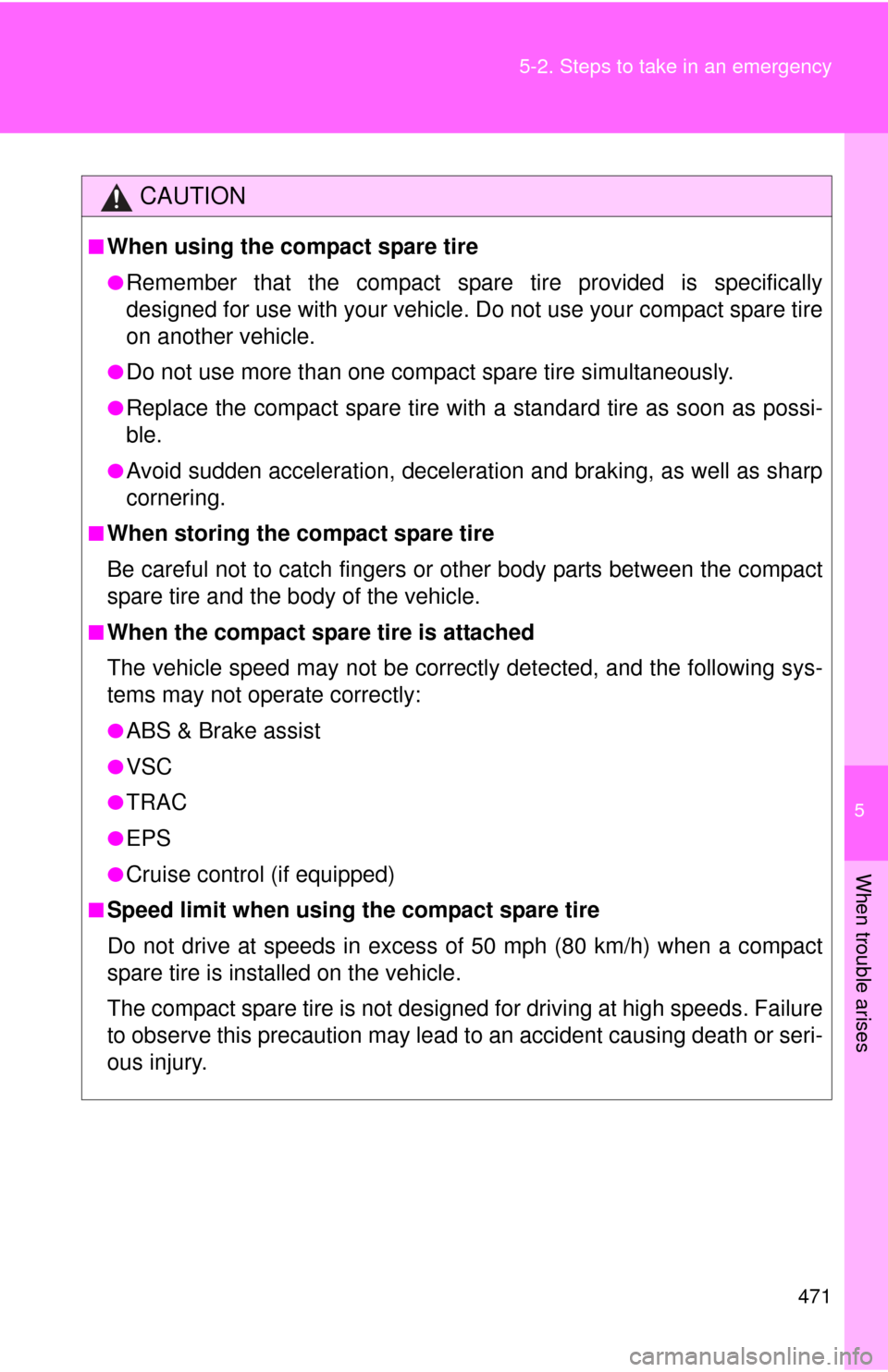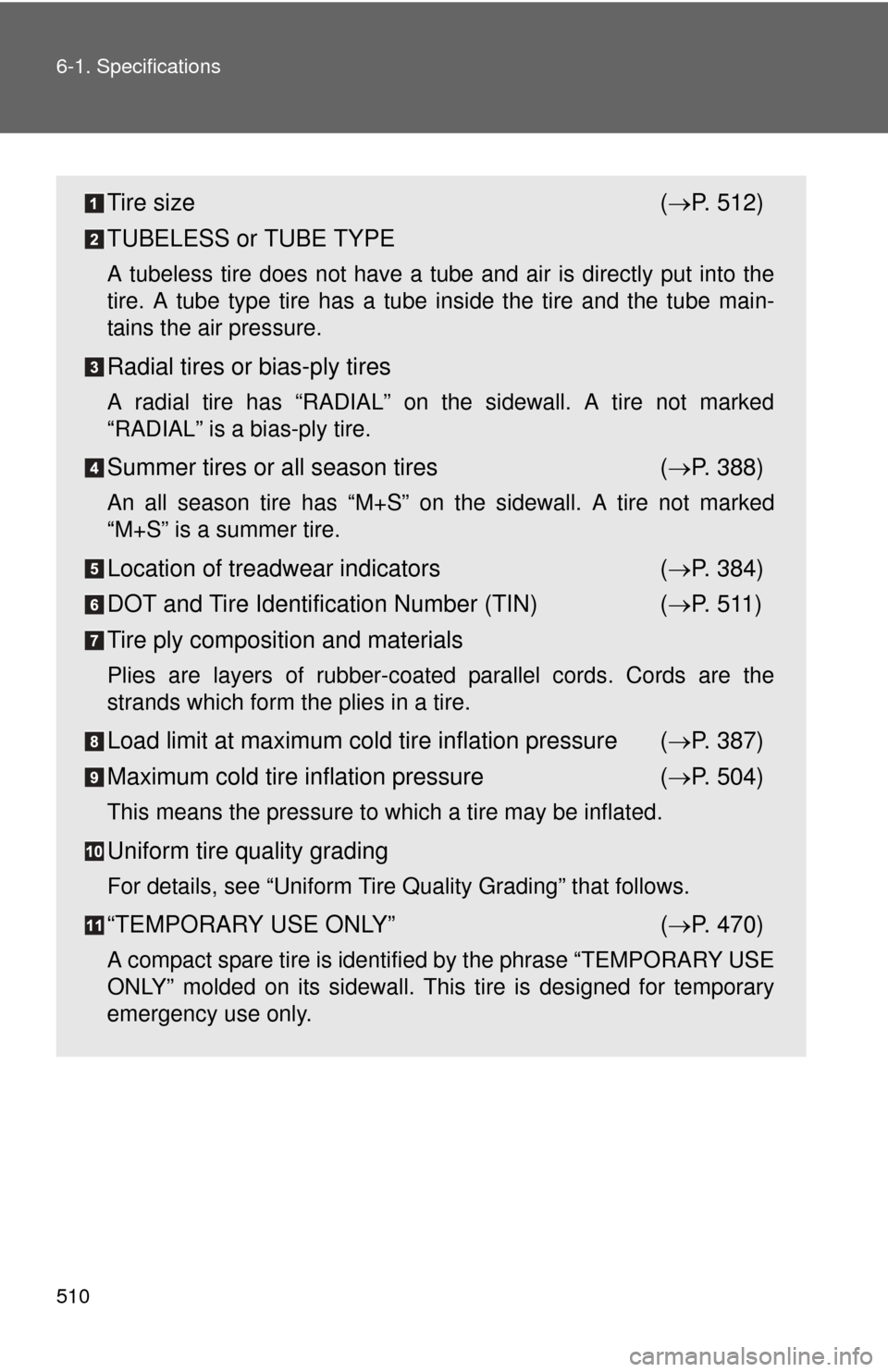Page 471 of 563
468 5-2. Steps to take in an emergency
Installing the compact spare tireRemove any dirt or foreign mat-
ter from the wheel contact sur-
face.
If foreign matter is on the wheel
contact surface, the wheel nuts
may loosen while the vehicle is
in motion, causing the tire to
come off.
Install the spare tire and loosely tighten each wheel nut by
hand by approximately the same amount.
When replacing a steel wheel
with a compact spare tire, tighten
the wheel nuts until the tapered
portion comes into loose contact
with the disc wheel seat.
When replacing an aluminum
wheel with a compact spare tire,
tighten the wheel nuts until the
tapered portion comes into loose
contact with the disc wheel seat.
STEP1
STEP2
Tapered portion
Disc
wheel
seat
Tapered portion
Disc
wheel
seat
Page 472 of 563
5
When trouble arises
469
5-2. Steps to take in an emergency
Lower the vehicle.
Firmly tighten each wheel nut
two or three times in the order
shown in the illustration.
Tightening torque:
76 ft•lbf (103 N•m, 10.5 kgf•m)
Stow the tire jack and all tools.
Stow the flat tire in the luggage
compartment as shown in the
illustration.
Stow the spare wheel cushions and luggage floor cover in the
luggage compartment.
STEP3
STEP4
STEP5
STEP6
STEP7
Page 473 of 563

470 5-2. Steps to take in an emergency
■The compact spare tire
●The compact spare tire is identified by the label “TEMPORARY USE
ONLY” on the tire sidewall.
Use the compact spare tire temporarily, and only in an emergency.
●Make sure to check the tire inflation pressu re of the compact spare
tire. ( P. 504)
■After completing the tire change
The tire pressure warnin g system must be reset. ( P. 385)
■When using the compact spare tire
As the compact spare tire is not equipped with a tire pressure warning
valve and transmitter, low inflation pressure of the spare tire will not be
indicated by the tire pressure warn ing system. Also, if you replace the
compact spare tire after the tire pressure warning light comes on, the
light remains on.
■If you have a flat front tire on a road covered with snow or ice
Install the compact spare tire on one of the rear wheels of the vehicle.
Perform the following steps and fit tire chains to the front tires:
Replace a rear tire with the compact spare tire.
Replace the flat front tire with the tire removed from the rear of
the vehicle.
Fit tire chains to the front tires.
STEP1
STEP2
STEP3
Page 474 of 563

5
When trouble arises
471
5-2. Steps to take in an emergency
CAUTION
■When using the compact spare tire
●Remember that the compact spare
tire provided is specifically
designed for use with your vehicle. Do not use your compact spare tire
on another vehicle.
●Do not use more than one compact spare tire simultaneously.
●Replace the compact spare tire with a standard tire as soon as possi-
ble.
●Avoid sudden acceleration, deceleration and braking, as well as sharp
cornering.
■When storing the compact spare tire
Be careful not to catch fingers or other body parts between the compact
spare tire and the body of the vehicle.
■When the compact spare tire is attached
The vehicle speed may not be correctly detected, and the following sys-
tems may not operate correctly:
●ABS & Brake assist
●VSC
●TRAC
●EPS
●Cruise control (if equipped)
■Speed limit when using the compact spare tire
Do not drive at speeds in excess of 50 mph (80 km/h) when a compact
spare tire is installed on the vehicle.
The compact spare tire is not designed for driving at high speeds. Failure
to observe this precaution may lead to an accident causing death or seri-
ous injury.
Page 477 of 563

474 5-2. Steps to take in an emergency
NOTICE
■Do not drive the vehicle with a flat tire.
Do not continue driving with a flat tire.
Driving even a short distance with a flat tire can damage the tire and the
wheel beyond repair.
■Be careful when driving over bumps with the compact spare tire
installed on the vehicle.
The vehicle becomes lower when driving with the compact spare tire
compared to when driving with standard tires. Be careful when driving
over uneven road surfaces.
■Driving with tire chains and the compact spare tire
Do not fit tire chains to the compact spare tire.
Tire chains may damage the vehicle body and adversely affect driving
performance.
■When replacing the tires
When removing or fitting the wheels, tires or the tire pressure warning
valve and transmitter, contact your Toyota dealer as the tire pressure
warning valve and transmitter may be damaged if not handled correctly.
■To avoid damage to the tire pressure warning valves and transmit-
ters
When a tire is repaired with liquid se alants, the tire pressure warning
valve and transmitter may not operate properly. If a liquid sealant is
used, contact your Toyota dealer or other qualified service shop as soon
as possible. Make sure to replace the tire pressure warning valve and
transmitter when replacing the tire. ( P. 385)
Page 507 of 563
504 6-1. Specifications
Tires and wheels
15-inch tires
16-inch tires
Tire size P175/65R15 84H, T125/70D16 96M
(spare)
Tire inflation pressure
(recommended cold
tire inflation pressure)Front:
35 psi (240 kPa, 2.4 kgf/cm
2 or bar)
Rear:
33 psi (230 kPa, 2.3 kgf/cm
2 or bar)
Spare:
60 psi (420 kPa, 4.2 kgf/cm
2 or bar)
Never exceed the maximum cold tire infla-
tion pressure indicated on the tire sidewall.
Wheel size 15 5J, 16 4T (spare)
Wheel nut torque 76 ft•lbf (103 N•m, 10.5 kgf•m)
Tire size P195/50R16 83V, T125/70D16 96M
(spare)
Front and rear tire inflation
pressure
(recommended cold tire
inflation pressure)Front:
32 psi (220 kPa, 2.2 kgf/cm
2 or bar)
Rear:
29 psi (200 kPa, 2.0 kgf/cm
2 or bar)
Spare:
60 psi (420 kPa, 4.2 kgf/cm
2 or bar)
Never exceed the maximum cold tire infla-
tion pressure indicated on the tire sidewall.
Wheel size 16 6J, 16 4T (spare)
Wheel nut torque 76 ft•lbf (103 N•m, 10.5 kgf•m)
Page 512 of 563
509
6-1. Specifications
6
Vehicle specifications
Tire infor mation
Typical tire symbols
Full-size tire
Compact spare tire
Page 513 of 563

510 6-1. Specifications
Tire size( P. 512)
TUBELESS or TUBE TYPE
A tubeless tire does not have a tube and air is directly put into the
tire. A tube type tire has a tube inside the tire and the tube main-
tains the air pressure.
Radial tires or bias-ply tires
A radial tire has “RADIAL” on the sidewall. A tire not marked
“RADIAL” is a bias-ply tire.
Summer tires or all season tires ( P. 388)
An all season tire has “M+S” on the sidewall. A tire not marked
“M+S” is a summer tire.
Location of treadwear indicators ( P. 384)
DOT and Tire Identification Number (TIN) ( P. 511)
Tire ply composition and materials
Plies are layers of rubber-coated parallel cords. Cords are the
strands which form the plies in a tire.
Load limit at maximum cold tire inflation pressure ( P. 387)
Maximum cold tire in flation pressure ( P. 504)
This means the pressure to which a tire may be inflated.
Uniform tire quality grading
For details, see “Uniform Tire Quality Grading” that follows.
“TEMPORARY USE ONLY” ( P. 470)
A compact spare tire is identified by the phrase “TEMPORARY USE
ONLY” molded on its sidewall. This tire is designed for temporary
emergency use only.